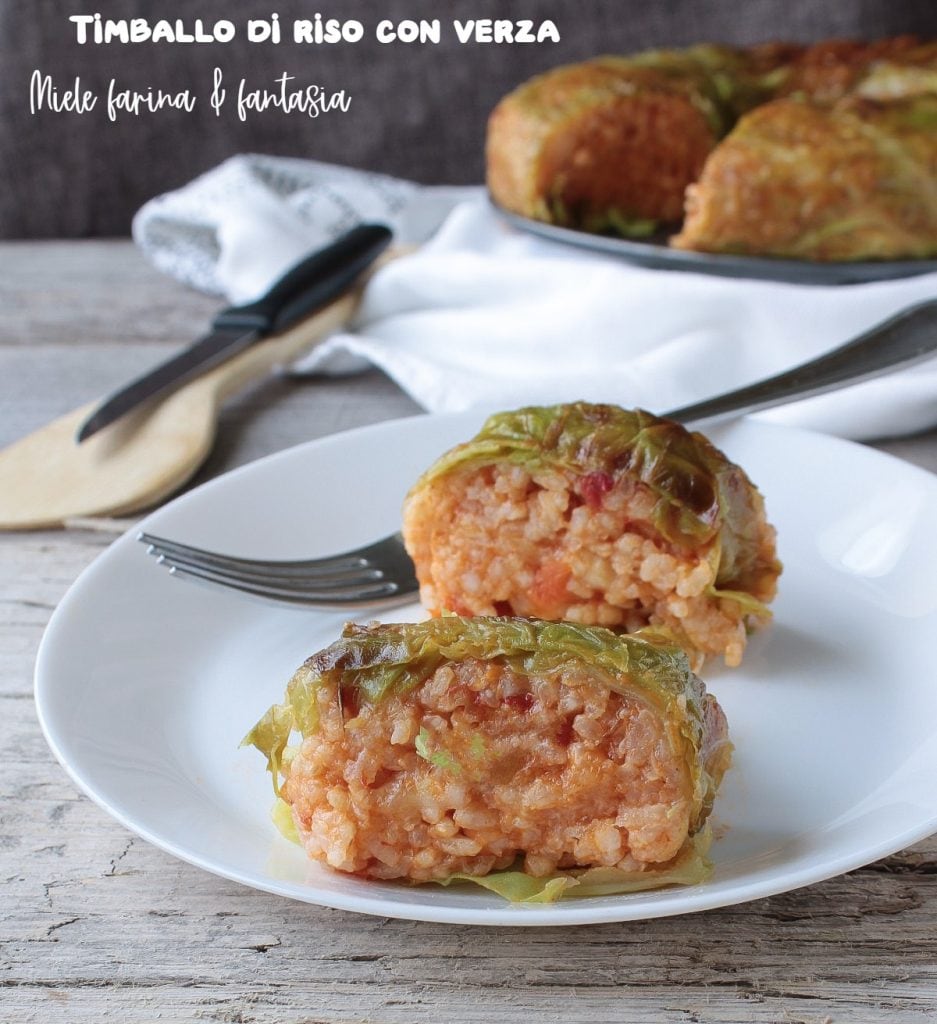Today I propose a recipe prepared with leftovers from Sunday lunch, namely boiled rice with which I had made Neapolitan arancini, Neapolitan ragù, cabbage that was sadly lying in the fridge, and gluten-free béchamel. The resulting dish, a rice timbale with cabbage, is amazing, delicious, gluten-free, perfect also as an idea for lunch or dinner during the week, as a work lunch or for a picnic. Like all my recipes, this one is also customizable according to tastes and needs; or, it can be intended as an idea to recycle leftovers in a tasty way, without too much effort and waste. The rice and cabbage timbale can also be prepared from scratch, with tomato sauce (faster than ragù) made on the spot; you can decide whether to add the béchamel or not and enrich the rice and cabbage timbale with cold cuts, mushrooms, and so on.

- Difficulty: Very Easy
- Cost: Very Cheap
- Preparation time: 30 Minutes
- Portions: 10
- Cooking methods: Oven, Boiling
- Cuisine: Italian
- Seasonality: Fall, Winter, and Spring
Ingredients
- 1 1/2 cups rice for timbales
- to taste fine salt
- 1 cup ragù
- 1/2 cup mix of grated pecorino and grana
- 8 leaves cabbage
- to taste shredded emmental
- to taste coarse salt (for blanching cabbage leaves)
- 1 cup milk (also lactose-free)
- 1 tbsp butter
- 2 tbsps cornstarch
- to taste fine salt
- to taste nutmeg
- to taste ground pepper
Tools
- 1 Springform Pan
Steps
1- To prepare our exquisite and rich rice and cabbage timbale, we start by boiling the rice (if we don’t have it already cooked) in plenty of salted water, cooking it for half the cooking time indicated on the package. The most suitable type of rice for this preparation is undoubtedly the one for timbales.
2- Let’s prepare the béchamel (if we don’t have it ready) as we are used to doing or as described here for the traditional béchamel, or here for the gluten and lactose-free version.
3- In the meantime, bring water to a boil in another tall pot to blanch the cabbage leaves
The cabbage leaves should be large and not too tender and thin because they would break (the initial ones are most suitable). Wash them and as soon as the water starts boiling, add a handful of coarse salt, let it return to a boil and plunge the cabbage leaves in.
In the meantime, fill a large bowl with cold water (and ice, if possible) and a little fine salt.
Blanch them for a maximum of 7 minutes, immediately drain them and plunge them into the cold water which will stop the cooking. Toss them around in the cold water, drain them, and let them drain in a colander from the excess water for about ten minutes. Probably not all the cabbage leaves will be needed; I always blanch a couple more in case some break. If you have leftovers, chop them very finely and add them to the rice mixture.
After about ten minutes, gently pat the leaves dry with some paper towels or a kitchen cloth without detergent smells.
Place them one at a time on a cutting board to remove the hard and fibrous central rib.
4- Take the mold (non-stick molds, like the one in the photo, do not need to be oiled or buttered for this type of preparation) and line it with the cabbage leaves, ensuring that one end hangs out of the mold while the other end rests inside the central hole of the mold.
5) Preheat the oven to 350°F
6- Drain the rice very well and leave it in the same cooking pot. Add the ragù (preferably warmed), the béchamel (also warm if possible), the grated cheeses, the shredded emmental (or other cheese to your liking or that you have as leftover) and mix to combine them perfectly. Taste and add more salt if deemed necessary.
7- Using a spoon, fill the mold with the seasoned rice, distributing it as evenly as possible inside the mold.
Cover the rice by folding over the ends of the cabbage leaves and bake in a preheated oven at 350°F for about 20 minutes, at mid-height.
Once the time is up, remove it from the oven and let it cool for a few minutes, so you can then move it without problems onto a serving plate. The rice timbale with cabbage should be eaten warm.
Bon appetit

